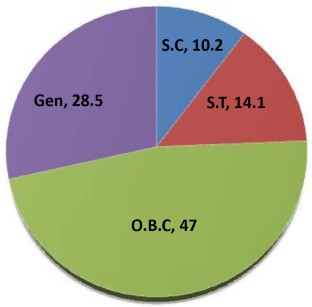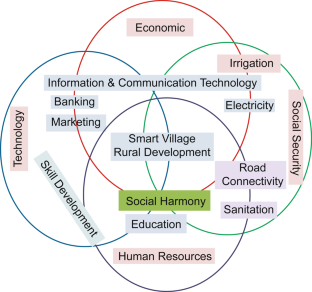Indian rural development: a review of technology and society

India has a large population of people who live in rural areas. Regional differences prevent every part of the country from being well developed. Among other factors, there are differences in cultural practices, living standards, and ownership of agricultural lands. Closing the gap requires the adoption of technology and a good education. This study observed that society, technology, and development are interrelated in rural India. Through technology-driven poverty reduction, underprivileged people can obtain education, health care, financial services, and employment opportunities. It is possible to improve agriculture and farmers’ economies through technological innovation combined with traditional knowledge.
This is a preview of subscription content, log in via an institution to check access.
Access this article
Springer+ Basic
€32.70 /Month
- Get 10 units per month
- Download Article/Chapter or eBook
- 1 Unit = 1 Article or 1 Chapter
- Cancel anytime
Buy Now
Price includes VAT (France)
Instant access to the full article PDF.
Rent this article via DeepDyve


Similar content being viewed by others

Role of Technology Management in Development
Chapter © 2013

Rural Development in Africa: Challenges and Opportunities
Chapter © 2020

A critical review of rural development policy of Ethiopia: access, utilization and coverage
Article Open access 13 August 2018
Data availability
Code availability
References
- Aghion P, David PA, Foray D (2009) Science, technology and innovation for economic growth: linking policy research and practice in ‘STIG Systems’. Res Policy 38(4):681–693. https://doi.org/10.1016/j.respol.2009.01.016ArticleGoogle Scholar
- Agwu ME (2021) Can technology bridge the gap between rural development and financial inclusions? Technol Anal Strateg Manag 33(2):123–133. https://doi.org/10.1080/09537325.2020.1795111ArticleGoogle Scholar
- Allain S, Ruault JF, Moraine M, Madelrieux S (2022) The ‘bioeconomics vs bioeconomy’ debate: beyond criticism, advancing research fronts. Environ Innov Soc Transit 42:58–73. https://doi.org/10.1016/j.eist.2021.11.004ArticleGoogle Scholar
- Arrieta-Escobar JA, Derrien D, Ouvrard S, Asadollahi-Yazdi E, Hassan A, Boly V, Tinet AJ, Dignac MF (2020) 3D printing: an emerging opportunity for soil science. Geoderma 378:114588. https://doi.org/10.1016/j.geoderma.2020.114588ArticleADSCASGoogle Scholar
- Ashley C, Maxwell S (2001) Rethinking rural development. Dev Policy Rev 19(4):395–425. https://doi.org/10.1111/1467-7679.00141ArticleGoogle Scholar
- Autio E, Mudambi R, Yoo Y (2021) Digitalization and globalisation in a turbulent world: centrifugal and centripetal forces. Glob Strategy J 11(1):3–16. https://doi.org/10.1002/gsj.1396ArticleGoogle Scholar
- Ayamga M, Tekinerdogan B, Kassahun A, Rambaldi G (2021) Developing a policy framework for adoption and management of drones for agriculture in Africa. Technol Anal Strateg Manag 33(8):970–987. https://doi.org/10.1080/09537325.2020.1858047ArticleGoogle Scholar
- Bansal S (2014) Perspective of technology in achieving financial inclusion in rural India. Procedia Econ Finance 11:472–480. https://doi.org/10.1016/S2212-5671(14)00213-5ArticleGoogle Scholar
- Baruah B (2015) Creating opportunities for women in the renewable energy sector: findings from India. Fem Econ 21(2):53–76. https://doi.org/10.1080/13545701.2014.990912ArticleGoogle Scholar
- Bhatnagar S, Schware R (2000) Information and communication technology in rural development. Case Studies From India, World Bank Institute, pp 1–192
- Bisht IS, Rana JC, Pal Ahlawat S (2020) The future of smallholder farming in India: some sustainability considerations. Sustainability 12(9):3751. https://doi.org/10.3390/su12093751ArticleGoogle Scholar
- Bizikova L, Nkonya E, Minah M, Hanisch M, Turaga RMR, Speranza CI, Karthikeyan M, Tang L, Ghezzi-Kopel K, Kelly J, Celestin AC, Timmers B (2020) A scoping review of the contributions of farmers’ organisations to smallholder agriculture. Nat Food 1(10):620–630. https://doi.org/10.1038/s43016-020-00164-xArticlePubMedGoogle Scholar
- Borooah VK, Iyer S (2005) Vidya, Veda, and Varna: the influence of religion and caste on education in rural India. J Dev Stud 41(8):1369–1404. https://doi.org/10.1080/00220380500186960ArticleGoogle Scholar
- Castañeda A, Doan D, Newhouse D, Nguyen MC, Uematsu H, Azevedo JP (2018) A new profile of the global poor. World Dev 101:250–267. https://doi.org/10.1016/j.worlddev.2017.08.002ArticleGoogle Scholar
- Cecchini S, Scott C (2003) Can information and communications technology applications contribute to poverty reduction? Lessons from rural India. Inf Technol Dev 10(2):73–84. https://doi.org/10.1002/itdj.1590100203ArticleGoogle Scholar
- Chand R (2017). Doubling farmers income: rationale, strategy, prospects & action plan. NITI Aayog Policy Paper No. 1/2017. https://www.niti.gov.in/writereaddata/files/document_publication/DOUBLING%20FARMERS%20INCOME.pdf. Accessed 20 May 2022
- Chand R, Saxena R, Rana S (2015) Estimates and analysis of farm income in India, 1983–84 to 2011–12. Econ Polit Wkly 139–145. https://www.jstor.org/stable/24482496
- Cozzens SE (2021) Inequalities and STI policies: impact analysis. Innov Dev 11(2–3):229–241. https://doi.org/10.1080/2157930X.2021.1973650ArticleGoogle Scholar
- de Fátima Ferreiro M, Sousa C, Sheikh FA, Novikova M (2021) Social innovation and rural territories: exploring invisible contexts and actors in Portugal and India. J Rural Stud. https://doi.org/10.1016/j.jrurstud.2021.04.013
- Deguchi A, Hirai C, Matsuoka H, Nakano T, Oshima K, Tai M, Tani S (2020) What is society 5.0. Society 5(0):1–24 Google Scholar
- De Haan LJ (2000) Globalisation, localization and sustainable livelihood. Sociol Ruralis 40(3):339–365. https://doi.org/10.1111/1467-9523.00152ArticleGoogle Scholar
- Dorin B (2022) Theory, practice and challenges of agroecology in India. Int J Agric Sustain 20(2):153–167. https://doi.org/10.1080/14735903.2021.1920760ArticleGoogle Scholar
- Fan S, Chan-Kang C (2005) Is small beautiful? Farm size, productivity, and poverty in Asian agriculture. Agric Econ 32:135–146 ArticleGoogle Scholar
- Galab S, Reddy PP, Raju DSR, Ravi C, Rajani A (2020) Impact assessment of zero budget natural farming in Andhra Pradesh. A comprehensive approach using crop cutting experiments. Report for the agricultural year 2018–19. https://apcnf.in/wp-content/uploads/2021/09/CESS-2018-2019-Report.pdf
- Goli S, Rammohan A, Reddy SP (2021) The interaction of household agricultural landholding and caste on food security in rural Uttar Pradesh, India. Food Secur 13(1):219–237. https://doi.org/10.1007/s12571-020-01109-9ArticleGoogle Scholar
- Haldar S (2021) Sustainable entrepreneurship development in the renewable energy sector: insights from Gujarat, India. Afr J Sci Technol Innov Dev 13(7):873–885. https://doi.org/10.1080/20421338.2020.1796004ArticleGoogle Scholar
- Hesham AEL, Kaur T, Devi R, Kour D, Prasad S, Yadav N, Singh C, Singh J, Yadav AN (2021) Current trends in microbial biotechnology for agricultural sustainability: conclusion and future challenges. In: Yadav AN, Singh J, Singh C, Yadav N (eds) Current trends in microbial biotechnology for sustainable agriculture. Environmental and microbial biotechnology. Springer, Singapore, pp 555–572. https://doi.org/10.1007/978-981-15-6949-4_22ChapterGoogle Scholar
- Himanshu, Lanjouw P, Murgai R, Stern N (2013) Nonfarm diversification, poverty, economic mobility, and income inequality: a case study in village India. Agric Econ 44(4–5):461–473. https://doi.org/10.1111/agec.12029ArticleGoogle Scholar
- Horton P, Brown GW (2018) Integrating evidence, politics and society: a methodology for the science–policy interface. Palgrave Commun 4(1):1–5. https://doi.org/10.1057/s41599-018-0099-3ArticleGoogle Scholar
- Internet – no author, 11/09/2021-70% of agricultural households possess land less than 1 hect. https://timesofindia.indiatimes.com/business/india-business/70-of-agricultural-households-possess-land-less-than-1-hectare-finds-survey/articleshow/86102412.cms. Accessed 24 May 2022
- Internet – no author, no date- India population. https://www.populationu.com/india-population. Accessed 19 May 2022
- Jha K, Doshi A, Patel P, Shah M (2019) A comprehensive review on automation in agriculture using artificial intelligence. Artif Intell Agric 2:1–12. https://doi.org/10.1016/j.aiia.2019.05.004ArticleGoogle Scholar
- Johnson DG, Wetmore JM (eds) (2021) Technology and society: building our sociotechnical future. MIT Press, Cambridge
- Kalinowski S, Rosa A (2021). Sustainable development and the problems of rural poverty and social exclusion in the EU countries. https://www.um.edu.mt/library/oar/bitstream/123456789/82063/1/Sustainable_development_and_the_problems_of_rural_poverty_and_social_exclusion_in_the_EU_countries.pdf. Accessed 12 May 2022
- Kareemulla K, Krishnan P, Ravichandran S, Kumar BG, Sharma S, Bhatta R (2021) Spatiotemporal analysis of size and equity in ownership dynamics of agricultural landholdings in India vis-à-vis the world. Sustainability 13(18):10225 ArticleGoogle Scholar
- Kumar SA, Ilango P (2018) The impact of wireless sensor network in the field of precision agriculture: a review. Wirel Pers Commun 98(1):685–698. https://doi.org/10.1007/s11277-017-4890-zArticleGoogle Scholar
- Lowenberg-DeBoer J, Huang IY, Grigoriadis V, Blackmore S (2020) Economics of robots and automation in field crop production. Precis Agric 21(2):278–299. https://doi.org/10.1007/s11119-019-09667-5ArticleGoogle Scholar
- Maertens A (2013) Social norms and aspirations: age of marriage and education in rural India. World Dev 47:1–15. https://doi.org/10.1016/j.worlddev.2013.01.027ArticleGoogle Scholar
- Masot AN, Gascón JLG (2021) Sustainable rural development: strategies, good practices and opportunities. Land 10(4):366. https://doi.org/10.3390/land10040366ArticleGoogle Scholar
- Muhardi M, Mafruhat AY, Cintyawati C, Ramli TA, Sabar R, Ahmad H, Shaharruddin S, Bohari AM (2022) The contribution of social, economy and technology in rural development. In: Rachmiatie A, Triwardhani IJ, Alhamuddin, Abdullah CU (eds) Islam, media and education in the digital era. Routledge, London, pp 27–33 ChapterGoogle Scholar
- Naika MB, Kudari M, Devi MS, Sadhu DS, Sunagar S (2021) Digital extension service: quick way to deliver agricultural information to the farmers. In: Food technology disruptions. Academic Press, pp 285–323 ChapterGoogle Scholar
- Pattnaik I, Lahiri-Dutt K (2022) Do women like to farm? Evidence of growing burdens of farming on women in rural India. J Peasant Stud 49(3):629–651. https://doi.org/10.1080/03066150.2020.1867540ArticleGoogle Scholar
- Poblete-Echeverría C, Fuentes S (2020) Special issue “Emerging Sensor Technology in Agriculture”. Sensors 20(14):3827. https://doi.org/10.3390/s20143827ArticleADSPubMedPubMed CentralGoogle Scholar
- Ravallion M (2011) A comparative perspective on poverty reduction in Brazil, China, and India. World Bank Res Obs 26(1):71–104. https://doi.org/10.1093/wbro/lkp031ArticleGoogle Scholar
- Ray N, Clarke G, Waley P (2021) The impact of contract farming on the welfare and livelihoods of farmers: a village case study from West Bengal. J Rural Stud 86:127–135. https://doi.org/10.1016/j.jrurstud.2021.06.003ArticleGoogle Scholar
- Ruel MT, Quisumbing AR, Balagamwala M (2018) Nutrition-sensitive agriculture: what have we learned so far? Glob Food Secur 17:128–153. https://doi.org/10.1016/j.gfs.2018.01.002ArticleGoogle Scholar
- Ryan M (2020) Agricultural big data analytics and the ethics of power. J Agric Environ Ethics 33(1):49–69. https://doi.org/10.1007/s10806-019-09812-0ArticleGoogle Scholar
- Schafft KA (2016) Rural education as rural development: understanding the rural school–community well-being linkage in a 21st-century policy context. Peabody J Educ 91(2):137–154. https://doi.org/10.1080/0161956X.2016.1151734ArticleGoogle Scholar
- Shamdasani Y (2021) Rural road infrastructure & agricultural production: evidence from India. J Dev Agric Econ 152:102686. https://doi.org/10.1016/j.jdeveco.2021.102686ArticleGoogle Scholar
- Sharma S (2015) Caste-based crimes and economic status: evidence from India. J Comp Econ 43(1):204–226. https://doi.org/10.1016/j.jce.2014.10.005ArticleGoogle Scholar
- Smith LC, Haddad L (2015) Reducing child undernutrition: past drivers and priorities for the post-MDG era. World Dev 68:180–204. https://doi.org/10.1016/j.worlddev.2014.11.014ArticleGoogle Scholar
- Sparrow R, Howard M (2021) Robots in agriculture: prospects, impacts, ethics, and policy. Precis Agric 22(3):818–833. https://doi.org/10.1007/s11119-020-097579ArticleGoogle Scholar
- Sahoo AK, Sangha D (2010) Diaspora and cultural heritage: the case of Indians in Canada. Asian Ethn 11(1):81–94 ArticleGoogle Scholar
- Tiwari C, Bhattacharjee S, Sethi P, Chakrabarti D (2022) Internal migration and rural inequalities in India. Popul Res Policy Rev 1–26. https://doi.org/10.1007/s11113-022-09707-5
- Ton G, Vellema W, Desiere S, Weituschat S, D’Haese M (2018) Contract farming for improving smallholder incomes: what can we learn from effectiveness studies? World Dev 104:46–64. https://doi.org/10.1016/j.worlddev.2017.11.015ArticleGoogle Scholar
- Truelove RN, Lellyett SC, Issaka AI, Huda S (2023) Agricultural value chains in developing economies: a theoretical framework. In: Sustainable food value chain development: perspectives from developing and emerging economies. Springer Nature Singapore, Singapore, pp 107–152 ChapterGoogle Scholar
- Wang D, Zhou T, Lan F, Wang M (2021) ICT and socio-economic development: evidence from a spatial panel data analysis in China. Telecommun Policy 45(7):102173. https://doi.org/10.1016/j.telpol.2021.102173ArticleGoogle Scholar
- Yadav A, Ahmad I (2022) Indian agriculture sector: impacts from COVID-19. Int J Global Environ Issues 21(1):4–22 ArticleGoogle Scholar
Acknowledgements
Funding
The authors did not receive support from any organization for the submitted work. The authors have no relevant financial or non-financial interests to disclose.
Author information
Authors and Affiliations
- School of Studies in Biotechnology, Jiwaji University, Gwalior, India Ravindra Verma
- Special Centre for Disaster Research, Jawaharlal Nehru University, New Delhi, India Kratika Verma
- Cluster Innovation Centre, University of Delhi, New Delhi, India Jahanvi Verma
- Department of Philosophy, Hansraj College, University of Delhi, New Delhi, India Tanya Singh
- School of Studies in Biotechnology, Jiwaji University, Gwalior, India Prakash S. Bisen
- Ravindra Verma




